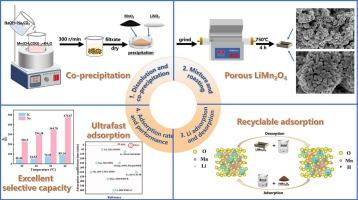Porous manganese-based ion sieve for sustainable lithium extraction from brine: High-efficiency adsorption and rapid kinetics
IF 9.8
1区 工程技术
Q1 ENGINEERING, CHEMICAL
引用次数: 0
Abstract
In response to the increasing demand for lithium in industrial applications, efficient lithium extraction methods have become a research focus. This study presents the synthesis of porous manganese-based lithium-ion sieve adsorbent (HMn2O4) for the selective recovery of lithium from brine. A high-temperature solid-phase method was employed to prepare a porous LiMn2O4 precursor, increasing the interaction between the adsorbent and lithium-containing solutions. The results showed that porous HMn2O4 achieved high adsorption rates and capacity, with the equilibrium reached in 5–30 min and lithium adsorption reaching up to 30.83 mg·g−1. Moreover, after ten adsorption-desorption cycles, the adsorption capacity of the sample remained at 91.85 % relative to the pristine adsorbent, demonstrating excellent stability and reusability. These findings suggest that the porous HMn2O4 adsorbent is a promising candidate for large-scale lithium extraction from salt lakes, providing a cost-effective and environmentally friendly solution to meet the growing demand for lithium.

多孔锰基离子筛萃取卤水锂:高效吸附和快速动力学
随着工业应用对锂的需求不断增加,高效的锂提取方法已成为研究热点。制备了多孔锰基锂离子筛吸附剂(HMn2O4),用于选择性回收卤水中的锂。采用高温固相法制备了多孔LiMn2O4前驱体,增加了吸附剂与含锂溶液的相互作用。结果表明,多孔HMn2O4具有较高的吸附速率和容量,在5 ~ 30 min内达到吸附平衡,锂吸附量可达30.83 mg·g−1。此外,经过10次吸附-解吸循环后,样品的吸附量相对于原始吸附剂保持在91.85%,表现出良好的稳定性和可重复使用性。这些发现表明,多孔HMn2O4吸附剂是盐湖大规模提取锂的理想选择,为满足日益增长的锂需求提供了一种经济、环保的解决方案。
本文章由计算机程序翻译,如有差异,请以英文原文为准。
求助全文
约1分钟内获得全文
求助全文
来源期刊

Desalination
工程技术-工程:化工
CiteScore
14.60
自引率
20.20%
发文量
619
审稿时长
41 days
期刊介绍:
Desalination is a scholarly journal that focuses on the field of desalination materials, processes, and associated technologies. It encompasses a wide range of disciplines and aims to publish exceptional papers in this area.
The journal invites submissions that explicitly revolve around water desalting and its applications to various sources such as seawater, groundwater, and wastewater. It particularly encourages research on diverse desalination methods including thermal, membrane, sorption, and hybrid processes.
By providing a platform for innovative studies, Desalination aims to advance the understanding and development of desalination technologies, promoting sustainable solutions for water scarcity challenges.
 求助内容:
求助内容: 应助结果提醒方式:
应助结果提醒方式:


